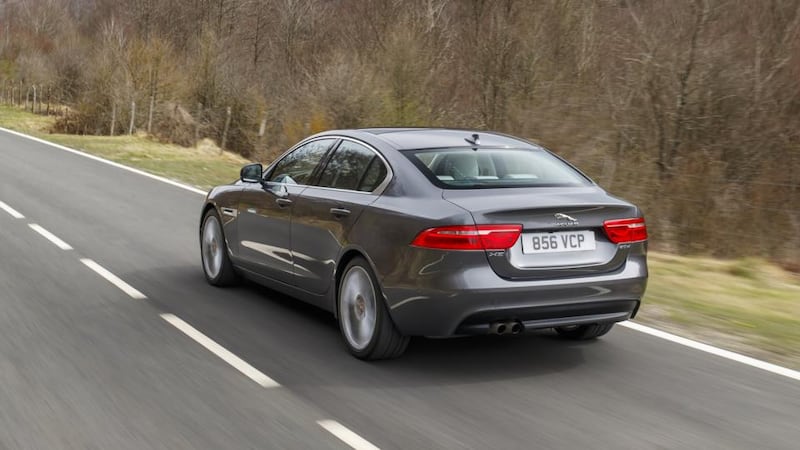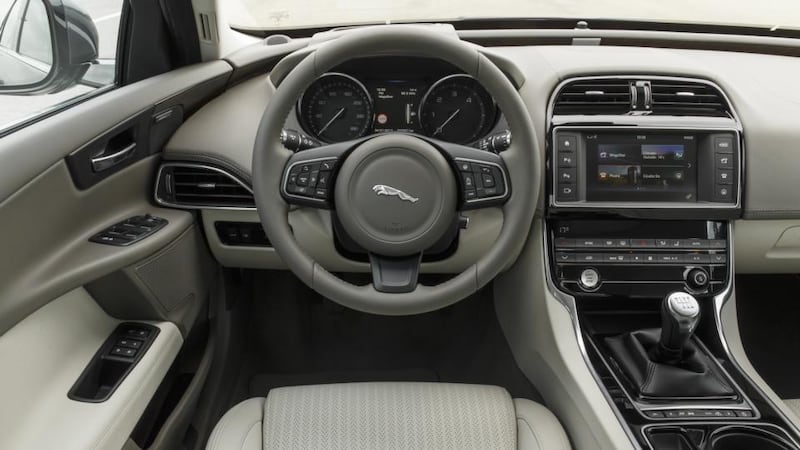In the midst of the multimillion euro fanfare surrounding the introduction of the Jaguar XE, it's easy to forget that its target market is the middle-class family motorist. Last year's unveiling included a fly-past under a helicopter along London's embankment and a West End musical telling the tale of a young designer whose life culminated in the creation of this car.
In hindsight, Jaguar may have lost the run of itself in terms of the razzmatazz, but the XE does represent a significant milestone in the reinvention of the big cat brand. And in terms of the motoring market, it will be their biggest fight to date: facing off against the heartland of German rivals BMW and Audi in a segment that's already losing ground to a plethora of crossovers and SUVs.
Yet it's perhaps timely for a brand that radically altered its image with the advent of the sleek XF saloon several years ago. Out went the musty world of the gentlemen's clubs, tweed and empire in the form of the S-Type and Ford Mondeo-derived X-Type. In came a brand proud of its heritage, but tapping more into the world of Kensington chic than Home Counties estate.


Its F-Type sports car continued that trend with its sleek lozenge profile. This XE certainly has coupe traits despite its four-door functionality, though it also carries a lot of similarities in its profile and creases to the BMW 3 Series.
Tech and design are the buzzwords around the brand these days. And it's a busy period for its engineers: the XE features the first use of the firm's new in-house diesel engine range, branded Ingenium. This four-cylinder 2-litre diesel puts out either 163bhp or 180bhp, mated to a six-speed manual or a very smooth eight-speed automatic transmission from ZF. In its smallest guise, and with low-resistance tyres, it achieves emissions of just 99g/km. Not too long ago that was hybrid territory. This same engine block will be added to the new Discovery Sport from sister brand Land Rover later this year.
Along with developing its own engines – courtesy of a new €500 million plant in Wolverhampton – the model range is also due to be increased. In September, the firm is due to unveil its new F-Pace crossover SUV, taking on the likes of the BMW X3 and Audi Q5. It will also square up against the new Discovery Sport.
Other engine options in the XE are a 230bhp 2-litre petrol or a 3-litre V6 petrol, the latter taken from the current F-Type range and powering the XE-S version. As expected, the V6 is loud, lairy and impressively adept. The 2-litre petrol, a Ford-supplied engine, is smooth when mated to the 8-speed auto box, if slightly underwhelming.
But it’s the diesels that will feature in most Irish cars. We got to test the 180bhp in various guises and, despite the remarkable smoothness of the autobox, preferred it with the six-speed manual transmission. There is admirable low-end torque, though the engine note when starting from cold is still a bit more rattle than hum. That’s not unique to Jaguar, but it’s always hard to marry the leaping cat with Otto Diesel’s soundtrack.
Chassis range
Alongside the engine variations there’s a host of other options for the XE. Part of this is in the chassis range. Much is being made by the firm of the XE’s sharper driving characteristics, hoping to match the benchmark set by BMW with its 3 Series. That’s partly why Jaguar has opted for the rear-wheel-drive format for its new entry model.
The XE offers four driving modes: dynamic, normal, eco and winter. After driving it nearly 500km on a variety of country roads threading their way through northern Spain, the conclusion was that you really need to keep it in dynamic mode to get the best from the car. The firm’s new electrically-assisted power steering – the first such system to be adopted in a Jaguar saloon – adjusts the weight of the steering feel according to the various driving modes, but when not engaged in dynamic mode it can feel a little too light.
Thanks to the use of a new Integral Link rear suspension, normally a feature of larger premium cars, there have been significant weight savings as the suspension is created with hollow-cast aluminium. The double-wishbone front suspension is also aluminium and is the same set-up that features on the firm’s F-Type sports car.
However, if you don’t fork out the optional €1,200 for the sports suspension on the 180bhp diesel or the petrol versions – standard on the R-Sport specification – then the ride and handling loses much of its edge over German rivals. It’s really a shame the sports suspension set-up is not the standard fit, for only then is the car really putting it up to the 3 Series in handling terms.
An optional feature on automatic transmission versions of the XE is what it calls All Surface Progress Control (ASPC). Effectively an advanced traction control system, it operates between 3km/h and 30km/h, working like a low-speed cruise control to deliver optimum traction in the most slippery conditions without skidding and without the driver using the pedals.
‘Riva loop’
Inside there are styling touches common to the rest of the range, including the sweeping “Riva loop” that runs from the front doors and around the top of the dash. Infotainment controls are largely through the 8-inch touchscreen system. Rear seat legroom is sufficient, though maybe not as good as its German rivals, but there is the chance of folding down the rear seats in a 40:20:40 format to increase bootspace, which is already a decent 400 litres.
Tech plays its part, with a new smartphone app that lets you remotely start the car, lock and unlock it and turn on the air-con to heat or cool the car before you get in. It’s also going to feature a new emergency call system and optional hotspot offering in the car, though the final details have yet to be confirmed.
With a limited number of models in the Jaguar range compared to its rivals, the addition of the XE certainly beefs up its offering on the forecourt. The XE is offered with 94 options and 160 accessories, so there is more variety than ever from the brand.
And there is undoubtedly more to come. While the engineers are coy about future derivatives, the XE platform will also lend itself to an estate format and perhaps another couple of iterations along the way. Meanwhile, the new XF is due on forecourts in late autumn, and an updated XJ is not far behind.
So it's a busy time for the British brand but the volumes will still remain some way off the heavyweight German brands. Yet that doesn't seem to bother Jaguar executives too much. "We don't want to be selling a million cars a year right now," says chief executive Ralph Speth. Some of its success is down to the fact that Jaguars remain a less frequent sight, something different in the increasingly uniform corporate car park.
The XE’s a well-built new entrant, with styling that perhaps looks a little too similar to rivals. It may have starred in its own West End show, it but doesn’t yet steal the limelight or the leading role from its German rivals.
The lowdown: Jaguar XE
Prices: Unconfirmed but expected to start close to €43,000
Engines: 2-litre 163bhp four-cylinder diesel putting out 380Nm of torque; 0-100km/h – 8.4 secs (manual); 3.8l/100km (75mpg); 99g/km. 2-litre 180bhp four-cylinder diesel putting out 430Nm of torque; 0-100km/h – 7.8 secs (manual); 4.2l/100km (67.3 mpg); 109g/km. 2-litre 200bhp petrol putting out 280Nm of torque with 8-speed auto transmission; 0-100km/h – 7.7 secs; 7.5l/100km (37.7mpg); 179g/km. 2-litre 240bhp petrol putting out 340Nm of torque with 8-speed auto transmission; 0-100km/h – 6.8 secs; 7.5l/100km (37.7mpg); 179g/km. 3-litre 340bhp petrol putting out 450Nm of torque with 8-speed auto transmission; 0-100km/h – 5.1 secs; 8.1l/100km (34.9mpg); 194g/km
Arriving in Ireland: June










